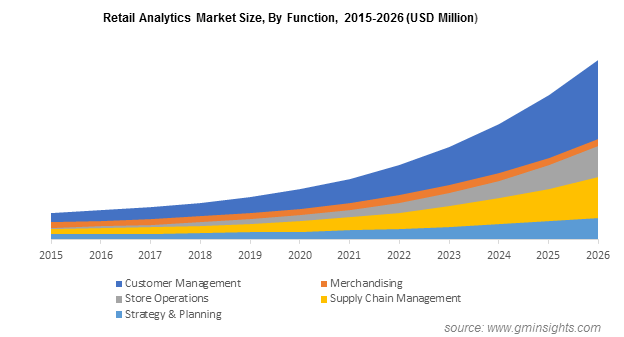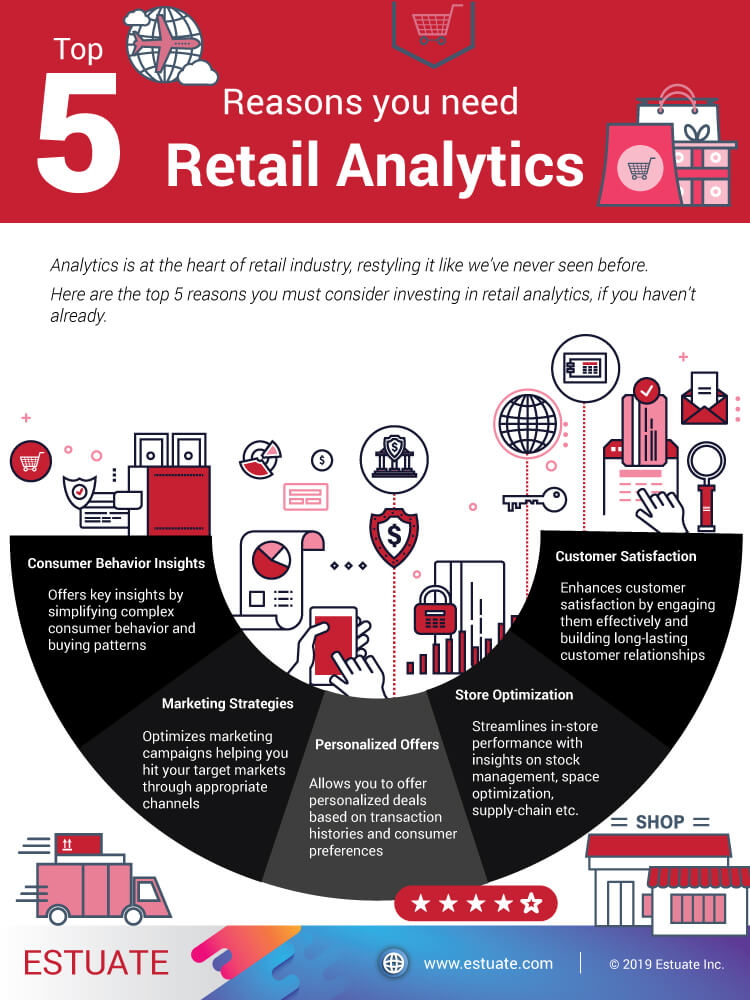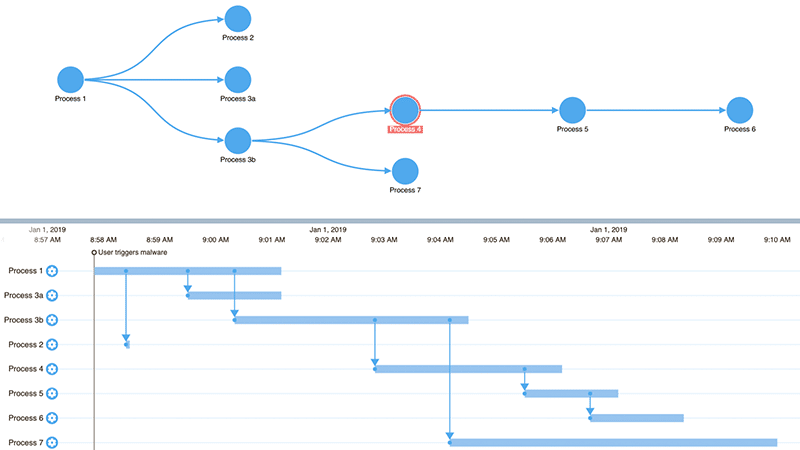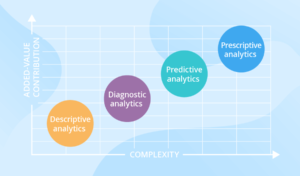Analytics make up the backbone of successful retail operations.
According to a report by Research and Markets, the global retail analytics market is expected to expand at a rate of 18% from 2019 to 2025. That means the market will be valued at over $9.5 billion in five years. So what warrants this soaring success?
The simple answer is—it works!
Retail analytics is seriously effective, and takes the guesswork out of business decision-making. When retail decisions are based on hard data rather than speculation, retailers make smarter business choices that result in increased customer satisfaction and revenues to match.
And that’s exactly why 90% of corporate strategies mention analytics as an essential competency.
We know that, for some, data harnessing can be daunting. So we’ve put together this resource to guide you through retail analytics as we move into an increasingly data-centric world.

Image: GM Insights
What is retail analytics?
Analytics describes the use of data-led tools to articulate business performance and patterns. Retail analytics is just the mobilization of business analytics in the retail sector.
Retailers use analytics to leverage valuable insights which can then inform their decision-making and improve operational efficiency, inventory planning, customer experience, and sales.
In short, retail analytics allows retailers to optimize every part of their business backend and frontend.
What’s more, retail analytics isn’t just about surface-level data points. Retail analytics is all about deep data, data mining, and multiple data sources. And this is what fuels the precision metrics upon which important decisions can be made with confidence.
This robust data allows retailers to:
- Identify their target personas
- Observe customer behavior and buying patterns
- Compare customer preferences
- Identify locational trends
What can retailers use retail analytics for?
Retail analytics has tons of use cases. In fact, it can be put to good use across almost every aspect of a retail business.
The retail industry is using data to thrive. Everything from customer research to supply chain management can be improved with robust data and analytics. Let’s take a look at some common use cases.
Identify your best customers
Retail analytics tools can help you identify your most lucrative customer demographics. When you know exactly who you’re marketing to, marketing campaigns improve on the back of your data.
When you know which products sell best, you’ll be able to forecast demand with greater accuracy.
Optimize inventory and procurement
Retail analytics tools are also great for your inventory and procurement management.
Predictive tools use historical data analysis to accurately predict order volumes. That means you’ll be able to reduce wasted warehousing space and those unpredictable inventory costs.
Identify customer trends and preferences
As well as helping you identify who your customers are, retail analytics tools can help you identify what your customers want at any given moment.
By accumulating sales data, analytics tools help retailers draw an accurate picture of customer preferences and habits.
Customer experience optimization
And, of course, this applies just as much to customer experience. Data analytics aids better communication because it helps us react to customer behavior in real-time.
For example, if the new sales checkout system that you’ve just implemented isn’t working well for customers, the data will flag this up so that you can make the necessary adjustment. In other words, retail analytics offers retailers a 360-degree view of their customers’ needs.

Image: Estuate

What types of data can be used in retail analytics?
Retail analytics tools make use of many different retail data sets. There are four main types of data that will most often get mobilized in retail analytics. Let’s take a closer look.
Image: SCNSoft
Descriptive analytics
Descriptive analytics is widely used. This is the data that tells you about your performance. Data is aggregated from your inventory systems, POS systems, ERPs, etc., to tell you exactly what is going on in your business in real-time.
Diagnostic analytics
Diagnostic analytics get to the bottom of why things are happening the way they are. They are great for ‘diagnosing’ problems as and when they occur. Diagnostic analysis combines statistical analysis with algorithms and machine learning to identify anomalies and flag up issues.
Predictive analytics
Predictive analytics is all about forecasting. It mobilizes descriptive and diagnostic data to make accurate performance forecasts for the future. Retail predictive analytics use AI and intelligent communications to figure out ‘what’s next?’
Prescriptive analytics
Lastly, prescriptive analytics (the most advanced analytics method) actually advises us on what to do under different circumstances!
Prescriptive analytics will make recommendations based on what has happened in the past and what is likely to happen in the future. This is achieved through simulations and AI algorithms which produce these recommendations on the basis of the best possible statistical outcome in any given situation.
Benefits and challenges of retail analytics
Many of the most successful retail brands use data-driven insights to make better decisions and fuel more sales. And whilst the benefits are many, there are some challenges when it comes to mobilizing analytics in your business.
Below we’ll outline the main benefits and challenges associated with retail analytics in practice.
Benefit # 1 – gain customer journey insight
Retail analytics platforms use customer data to help businesses understand customer behavior more intimately at every point along the customer buying journey.
This means you’ll be able to form stronger customer relationships by offering improved, customer-centric experiences across the board.
Challenge #1 – adopting the right technologies
To get the most out of analytics and gain a competitive advantage, you’ll need to adopt the right technologies in a timely manner.
Getting used to a new way of doing things can take time, so make sure to invest in a tool with a simple implementation process and plenty of support.
Benefit #2 – enhancing customer experiences
Retail analytics tools help retailers enhance their customers’ experiences with shopper data. When you know exactly what your customers’ preferences are, then you’ll be able to deliver the best experiences and the right products, and ensure loyal customer retention.
Challenge #2 – bringing disparate systems together
If you’re using lots of different business software systems (CRM, billing software, inventory planning, etc.) then you’ll need to unify these systems in order to streamline data collection.
This can be quite a challenging process, but it’s absolutely essential for accurate data collection.
Benefit #3 – anticipate demand without guesswork
One of the greatest benefits when it comes to retail analytics is the elimination of guesswork from business decision-making.
Manual forecasting is rife with error. Using a retail analytics tool will help you forecast and plan for the future with accuracy, optimize supply chains, and (ultimately) generate more revenue in the process.
Challenge #3 – data security and compliance
Finally, with data comes compliance issues. Data management comes with rules and regulations. You’ll need to make sure that you are carrying out any necessary security audits and become literate in data compliance laws in your area.

How can retail analytics help improve supply chain efficiency?
Managing supply chains is a complicated business. Especially if you’re trying to do it manually.
It’s easy to lose track as demand for online purchases fluctuates. Retail analytics can improve supply chain efficiency making it easier to manage deliveries, pick items, and deal with vendors.
Here are some more ways retail analytics can improve your supply chain efficiency for good.
Real-time delivery tracking
Big data helps businesses manage deliveries in real-time by making sure goods always get delivered to stores and customers as quickly as possible.
Retail analytics solutions offer real-time delivery tracking. You’ll know exactly where your products are every step of the way along the journey to fulfillment.
Image: Metapack
Pick and pack orders
Picking and packing orders can be labor-intensive and time-consuming. But the process can be expedited with analytics.
By collating data on warehouse layouts, inventory volumes, and picking times, analytics systems can develop a unique, optimized picking process. And that means time and money savings for you!
Segment your supply chains
We live in the age of personalization, and that’s impacting our supply chain management considerably. Customers want services tailored to their individual needs.
By segmenting your supply chains with the help of retail analytics data, you’ll be able to provide more personalized services for your shoppers based on their individual interactions with your business.
Manage multiple vendors
As a multichannel retailer online, you’ll have lots of vendors to manage simultaneously. And doing this without the help of data is nearly impossible. Analytics tools are a great way to manage your vendors.
You’ll be able to assess vendor performance, track fulfillment times, and customer experiences. For example, if your delivery fulfillment provider is consistently slow, you’ll know right away. Likewise, if your packing vendors aren’t meeting customer expectations you’ll be able to fix the problem in a timely manner.
Plan with accuracy
Finally, retail analytics allows retailers to plan with greater accuracy. Data fuels more accurate forecasts.
Machine learning algorithms mine data and can identify trends, consumer behaviors, product performance, and make stock level predictions. And, at the end of the day, accurate planning means more efficient processes and reduced costs.
How do you do supply chain analysis?
It’s important to keep monitoring your supply chain to make sure everything is ticking over efficiently. And in order to do that, you’ll need to conduct a supply chain analysis.
Here’s how to do just that!
Step 1: Map your supply chain
First thing’s first, map out your entire supply chain. This should include all the people, resources, activities, and information involved in your supply chain from procurement to fulfillment. You could create a flowchart or use a supply chain management tool.
Step 2: Map out the market
Next, map out your market. Who are your competitors? Who are your suppliers? Are your materials seasonal? How much does everything cost (transport, materials, labor)? Can you look for suppliers with more competitive pricing? How can you compete with your competitors and source the best deals out there to protect those overheads?
Step 3: Identify inefficiencies
Now that you’ve mapped out your market and supply chain in full, you can identify any inefficiencies that need to be rectified.
Inefficiencies include things like complicated purchasing models and overspending in a particular area. For example, perhaps you could lower your shipping costs by switching to a different shipping provider.
Step 4: Optimize procedures
Once all of those inefficiencies are identified, it’s time to do something about it. Make any changes necessary to optimize your supply chain both financially and operationally.
This is the time to change suppliers, reduce spending, and get your supply chain model as efficient as possible.
Step 5: Do it all again
The final step is to do it all again! Supply chain analyses should be carried out regularly. After all, the market changes and fluctuates all the time.
Here’s an example of a supply chain data visualization:

Image: Cambridge Intelligence
Extra tips for improving your supply chain analysis
Want an even more in-depth supply chain analysis?
Your supply chain analysis can be as basic or complex as you choose to make it. Feel free to build on your supply chain analysis framework for even better results.
For example, you might want to integrate more supply chain data. You could include:
- Sales forecasts
- Financial systems data
- Your ERP data
- Resource management system data
Make sure that you’re eliminating any duplicate data as well.
One of the best ways to improve your supply chain analysis is to always think ahead. Make sure that you’re actively improving your supply chain both for now and for the future.
If you’re planning to grow in the near future, ensure that production lines and procurement costs are optimized and sufficiently scalable.
How retail analytics is evolving
Retail analytics is here to stay. But it’s also constantly evolving. More and more firms are moving towards a data-driven model and retail is pushing ahead in this arena.
We’ve moved beyond basic reporting and into an age of predictive and prescriptive retail analytics. With the right tools at the helm, you’ll be able to mobilize retail analytics and future proof your omnichannel retail ecommerce business.

